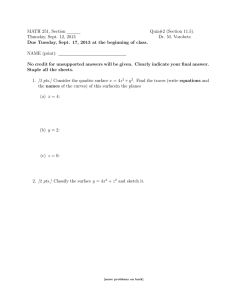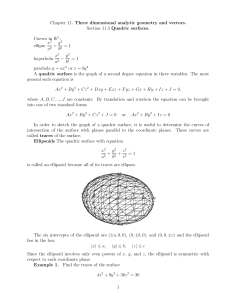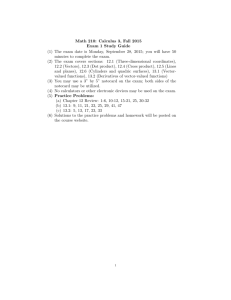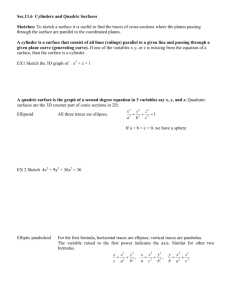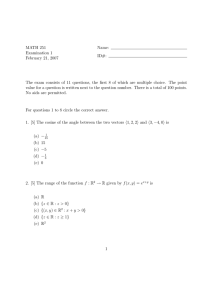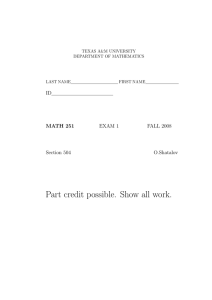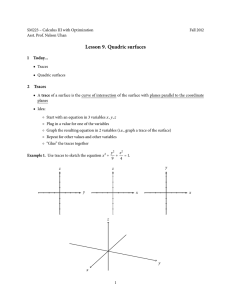Section 11.5: Quadric Surfaces
advertisement
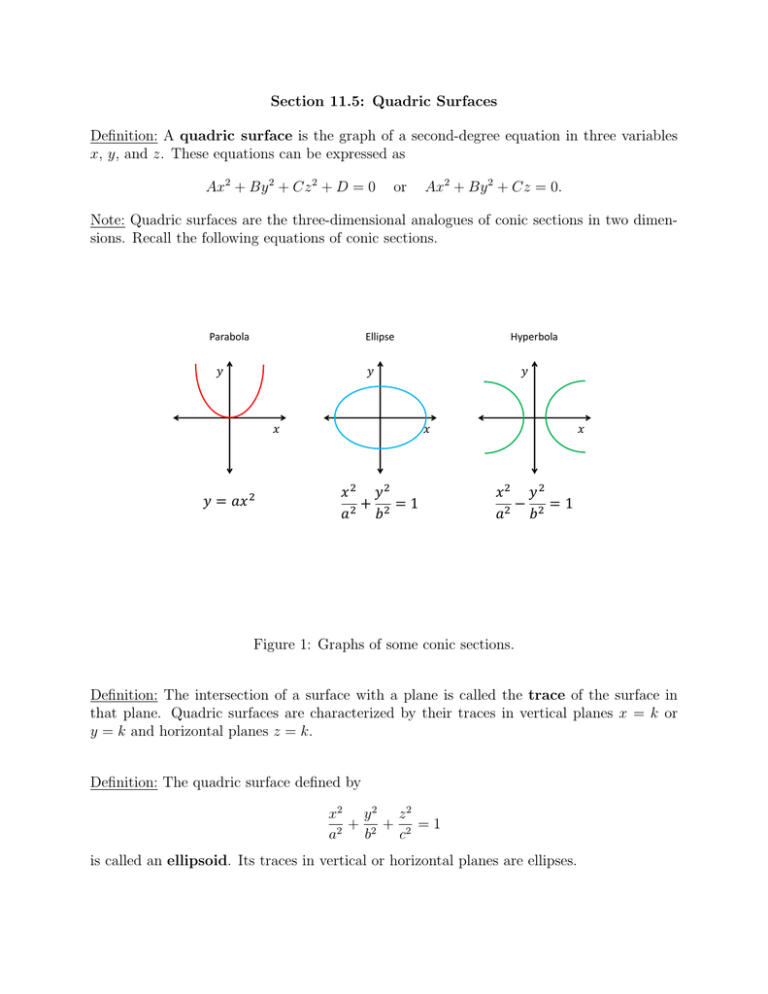
Section 11.5: Quadric Surfaces Definition: A quadric surface is the graph of a second-degree equation in three variables x, y, and z. These equations can be expressed as Ax2 + By 2 + Cz 2 + D = 0 or Ax2 + By 2 + Cz = 0. Note: Quadric surfaces are the three-dimensional analogues of conic sections in two dimensions. Recall the following equations of conic sections. Parabola Hyperbola Ellipse 𝑦 𝑦 𝑦 𝑥 𝑦 = 𝑎𝑥 2 𝑥 𝑥2 𝑦2 + =1 𝑎2 𝑏 2 𝑥 𝑥2 𝑦2 − =1 𝑎2 𝑏 2 Figure 1: Graphs of some conic sections. Definition: The intersection of a surface with a plane is called the trace of the surface in that plane. Quadric surfaces are characterized by their traces in vertical planes x = k or y = k and horizontal planes z = k. Definition: The quadric surface defined by x2 y 2 z 2 + 2 + 2 =1 a2 b c is called an ellipsoid. Its traces in vertical or horizontal planes are ellipses. Figure 2: Graph of the ellipsoid x2 + y2 + z 2 = 1. 4 Definition: The quadric surface defined by x2 y 2 z 2 + 2 − 2 =1 a2 b c is called a hyperboloid of one sheet. Its traces in horizontal planes z = k are ellipses and its traces in vertical planes x = k or y = k are hyperbolas. Figure 3: Graph of the hyperboloid of one sheet x2 y 2 + − z 2 = 1. 4 9 Definition: The quadric surface defined by z 2 x2 y 2 − 2 − 2 =1 c2 a b is called a hyperboloid of two sheets. Its traces in vertical planes x = k or y = k are hyperbolas and its traces in horizontal planes z = k for |k| > c are ellipses. x2 y 2 Figure 4: Graph of the hyperboloid of two sheets z − − = 1. 4 9 2 Definition: The quadric surface defined by x2 y 2 z2 + = a2 b2 c2 is called a cone or elliptic cone. Its traces in vertical planes x = k or y = k are hyperbolas for k 6= 0 and lines for k = 0. Its traces in horizontal planes z = k 6= 0 are ellipses. x2 y 2 Figure 5: Graph of the cone z = + . 4 9 2 Definition: The quadric surface defined by z x2 y 2 = 2+ 2 c a b is called an elliptic paraboloid. Its traces in horizontal planes z = k are ellipses and its traces in vertical planes x = k or y = k are parabolas. Figure 6: Graph of the elliptic paraboloid z = x2 y 2 + . 4 9 Definition: The quadric surface defined by x2 y 2 z = 2− 2 c a b is called a hyperbolic paraboloid. Its traces in vertical planes x = k or y = k are parabolas and its traces in horizontal planes z = k are hyperbolas. Figure 7: Graph of the hyperbolic paraboloid z = x2 y 2 − . 4 9 Example: Describe the graph of 3x2 − 12y 2 + z 2 = 12. In standard form, the equation is x2 z2 − y2 + = 1. 4 12 To determine the type of surface, we examine traces of the surface in vertical and horizontal planes. In the xy-plane (z = 0), the trace is a hyperbola x2 − y 2 = 1. 4 In the xz-plane (y = 0), the trace is an ellipse x2 z 2 + = 1. 4 12 In the yz-plane (x = 0), the trace is a hyperbola z2 − y 2 = 1. 12 Thus, the surface is a hyperboloid of one sheet. Example: Describe the graph of x y2 = + z2. 6 3 In standard form, the equation is x = 2y 2 + 6z 2 . In the xy-plane (z = 0), the trace is a parabola x = 2y 2 . In the xz-plane (y = 0), the trace is a parabola x = 6z 2 . In the plane x = 6, the trace is an ellipse y2 + z 2 = 1. 3 Thus, the surface is an elliptic paraboloid. Note: If one of the variables x, y, or z is missing from the equation (free variable), then the surface is a cylinder. Figure 8: Graph of the parabolic cylinder y = x2 in R3 . y2 = 1 in R3 . Figure 9: Graph of the elliptic cylinder x + 4 2 Example: Describe the graph of x2 y 2 − = 1. 4 16 Since z is a free variable, the trace in every horizontal plane z = k is a hyperbola. Thus, the surface is a hyperbolic cylinder centered about the z-axis. Example: Find an equation for the surface obtained by rotating the line x = 2y about the x-axis. The equation of the line is y = x2 . Revolving this line about the x-axis gives a circular cone centered about the x-axis. The traces in vertical planes x = k are circles centered at (y, z) = (0, 0) with radius r = y = x2 . Thus, the equation of the surface is x 2 y2 + z2 = 2 2 2 2 4y + 4z = x . 𝑦 𝑧 𝑟 𝑥 𝑦 𝑟 𝑥 𝑟=𝑦= 𝑥 2 𝑥 2 2 4𝑦 2 + 4𝑧 2 = 𝑥 2 𝑦2 + 𝑧2 = Figure 10: Graph of the circular cone x2 = 4y 2 + 4z 2 .
